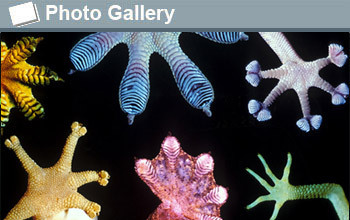![]()
Press Release 14-056
Special for Earth Day: New NSF resources highlight surprising ecological and economic benefits of biodiversity![]()
Multimedia resources explain little known societal benefits of biodiversity, bust myths and describe new, high-tech approaches for measuring impacts of environmental change on biodiversity
|
A slideshow on how biodiversity boosts the economy. |
April 17, 2014
Every organism on Earth, from microbes to plants to large predators, has evolved unique survival mechanisms and distinct ecological roles. For decades, the National Science Foundation (NSF) has funded basic research on how these varied organisms, which make up the Earth’s biodiversity, function.
For example, recent findings about how geckos climb up vertical walls and walk across ceilings led to the development of new adhesives and wall-climbing robots that may be used to, for example, produce new gravity-defying climbing boots and help collect space junk. (Learn more about gecko-inspired discoveries in the accompanying slide show.)
Kellar Autumn of Lewis & Clark College, who helped characterize the nanophysics of the gecko’s Spider Man-like abilities, said, “Geckos, which evolved 160 million years ago are so novel that engineers would never have developed nano-adhesive structures without them. It took 15 years and lots of NSF support to understand the basic physical principles of gecko adhesion and then to apply them to make them work. This suggests that there is a library of biodiversity that can be mined for valuable uses if we have enough resources and enough time–in light of high extinction rates–to really understand them.”
New resources
Learn more about the amazingly diverse ecological and economic benefits of biodiversity and its enduring mysteries from these accompanying resources:
- 10 Surprising Ways that Biodiversity Benefits the Economy: A slide show about how basic research on biodiversity drives innovation, boosts the economy and produces other important societal benefits.
- Biodiversity: A Boon to Brain Research: A video about how two unlikely microbes (that don’t even have brains) made possible the development of one of today’s most promising brain research tools–which is being used to study many brain diseases and disorders, including schizophrenia, Parkinson’s, epilepsy and anxiety.
- NEON at a Glance: A video about the National Ecological Observatory Network (NEON)–which will be a massive nationwide infrastructure for collecting standardized long-term data on biodiversity (and other ecological variables) throughout the United States. Currently under construction and partially operational, NEON will enable scientists to generate the first apples-to-apples comparisons of ecosystem health over time. NEON will be fully operational in 2017.
- A Google+ Hangout on the surprising ecological and economic benefits of biodiversity: Held on April 17, 2014, the Hangout covered ecological benefits of biodiversity that have been scientifically tested and others that have yet to be tested; how biodiversity boosts scientific and engineering innovation and new tools used to measure biodiversity in the face of environmental change.
Panelists in the Hangout were:
- Ed Boyden of MIT: A neuroscientist and expert on how studies of biodiversity have helped generate revolutionary new research tools. A recent press release on Boyden’s brain research reviews the contributions of biodiversity to his research advances.
- Bradley Cardinale of the University of Michigan: An expert on the impacts of humans on biodiversity and ecosystem health, and on how losses of biodiversity may impact ecological processes.
- Sarah Bergbreiter of the University of Maryland: An expert in insect-inspired robotics. Bergbreiter’s research on micro robots was covered in a recent Science Nation video.
- Steve Polasky of the University of Minnesota: An expert on integrating ecological and economic analyses, biodiversity conservation and ecosystem services.
- Elizabeth Blood of NSF: NSF’s program director for NEON.
-NSF-
![]()
Media Contacts
Lily Whiteman, National Science Foundation, (703) 292-8310, lwhitema@nsf.gov
Related Websites
Following in the Footsteps of Nature (article about gecko-inspired innovations): http://www.nsf.gov/discoveries/disc_summ.jsp?cntn_id=116297
![]()
The National Science Foundation (NSF) is an independent federal agency that supports fundamental research and education across all fields of science and engineering. In fiscal year (FY) 2014, its budget is $7.2 billion. NSF funds reach all 50 states through grants to nearly 2,000 colleges, universities and other institutions. Each year, NSF receives about 50,000 competitive requests for funding, and makes about 11,500 new funding awards. NSF also awards about $593 million in professional and service contracts yearly.
Useful NSF Web Sites:
NSF Home Page: http://www.nsf.gov
NSF News: http://www.nsf.gov/news/
For the News Media: http://www.nsf.gov/news/newsroom.jsp
Science and Engineering Statistics: http://www.nsf.gov/statistics/
Awards Searches: http://www.nsf.gov/awardsearch/
![]()
